Untitled - Sexey's School Moodle
Untitled - Sexey's School Moodle
Untitled - Sexey's School Moodle
Create successful ePaper yourself
Turn your PDF publications into a flip-book with our unique Google optimized e-Paper software.
only adds to its value as cultural capital. On the other hand, her analysis of The Monk<br />
offers some insightful counterpoints that are worth considering.<br />
138<br />
Napier claims that The Monk fails to deliver the “openness” it promises in its<br />
beginning because both the social criticism and the premise of psychological depth are<br />
designed primarily to feed on the reader’s voyeuristic impulses (115). But rather than<br />
dismissing the value of The Monk based on this view, I would argue that it is specifically<br />
that which makes it an interesting illustration of Bataille’s conceptualization of Eroticism<br />
and transgression as explored in Chapter 2. Her analysis of various scenes, such as the<br />
repeated sexual allusions regarding Antonia’s physique, prompts Napier to draw the<br />
following conclusion:<br />
The deliberate and repeated sensual orientation of The Monk<br />
(whether Lewis is describing scenes of sexuality or of punishment),<br />
combined with incidents in which physical beauty is associated<br />
with a form of excited or confused withdrawal, puts the reader in<br />
the novel’s most crucial moments in the position of a voyeur,<br />
watching curiously … from afar. (117)<br />
In another instance, she draws from the scene where the Monk is watching Antonia<br />
taking a bath through Matilda’s mirror (271) to argue that the narrator does not allow the<br />
reader “to formulate a moral judgment—either about Lewis or perhaps about himself for<br />
his reaction to the event” and that the reader “is encouraged to share [Ambrosio’s]<br />
physiological (non-moral) reaction: her ‘contours’ are called ‘voluptuous’ and the linnet’s<br />
harbour between her breasts adjudged ‘delightful’” (118). Hence, Napier claims that The<br />
Monk draws the reader into a scopophilic contemplation of some of the female characters.<br />
In doing so, she seems to suggest that there is a rapprochement between reader and<br />
narrator, which at times, provokes the reader into assuming Ambrosio’s point of view. In



